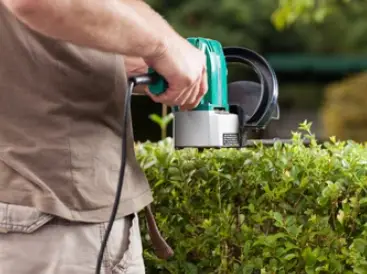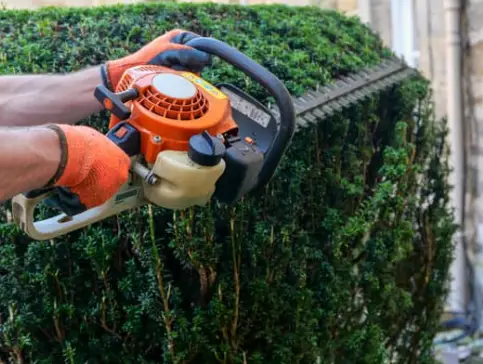Whenever you buy something, it’s good to know that you’re getting the best value for money. This applies to hedge trimmers as much as any other item. The trouble is that there are so many brands that it’s not easy to know which one to go for.
We’ve picked out two well-respected brands (though there are plenty of other excellent ones to choose from!) and we’re going to compare them to see which is best.
It’s a great exercise; even if you end up avoiding both and choosing another brand entirely, this will give you an idea of what features and specifications to watch out for.
So, without further delay, let’s check out Echo Vs Stihl.
Echo Vs Stihl: Electric Corded Hedge Trimmers
This particular competition is a little one-sided, as Stihl makes corded electric trimmers but Echo doesn’t!
However, we may as well take a look at what Stihl has to offer. It also gives us an opportunity to establish the main issues to focus on.

Power
We investigated four Stihl trimmers; the HSE42, HSE52, HSE71 and HSE81.
As you might guess, the higher the number, the better the specifications. So, here are the power outputs for each:
- HSE42 – 420 watts
- HSE52 – 460 watts
- HSE71 – 600 watts
- HSE81 – 650 watts
The smallest motor is perfect for light trimming and general gardening tasks, but if you want more power you can opt for one of the bigger sizes. The HSE81 delivers 650 watts, which is more than enough for pretty heavy-duty work.
Weight
This is one of the main factors to consider when buying a hedge trimmer of any type. You’ll be holding this machine for a while when gardening, and you’ll need to be able to extend your arms while moving around. If the hedge trimmer is too heavy for you, there’s a danger that you’ll drop it or become unbalanced.
The four Stihl trimmers range from 3kg (the HSE42) to 4.4kg (the HSE81), neither of which should be too heavy for the average gardener.
Noise Level
Modern corded electric hedge trimmers are a lot less noisy than many examples in the past. They are certainly nowhere near as loud as most petrol-powered hedge trimmers.
Even so, anything above 85 dB (decibels) can damage your hearing if you are exposed to it for long periods.
Our four trimmers push out between 95 and 99 dB, although the sound pressure level is between 84 and 88 dB. Without going into the technicalities, the sound pressure level gives a better idea of how the noise will impact your hearing.
On the whole, the Stihl hedge trimmers are considered quiet enough that you don’t need to wear ear protection.
Cable Length
All of these models come with a 10-metre power cable as standard. This is pretty generous and makes these trimmers ideal for small or medium-sized gardens without having to use an extension cord.

Price
This aspect is probably the most important for many buyers. It isn’t always easy to decide whether to pay the extra for a long-established premium brand or to risk a cheaper alternative.
Although we can’t compare Stihl and Echo hedge trimmers in this category, we can look at Stihl’s prices:
- HSE42 – £130
- HSE52 – £170
- HSE71 – £265
- HSE81 – £330
As you can see, that’s quite a jump from the lowest to the highest price!
While it’s true that you get the quality you expect from the Stihl name, it’s also fair to say that there are cheaper alternatives that are equally as good.
Blade Length
The length of the cutting blade is important as it determines how much you can cut in a single sweep. Shorter blades will necessarily mean more sweeps across the hedge.
Also, the width of your hedges needs to be considered; a 20cm blade won’t even reach halfway across the top of a hedge or bush that’s 60cm wide. And unless you have access to both sides, you have a problem.
However, don’t think you can solve this by getting the longest blade possible! Longer blades usually result in heavier machines that can make your arms tire easily or put you off balance.
It’s important to consider all the information to find the best hedge trimmer for your needs.
The blade lengths for our examples are as follows:
- HSE42 – 45cm (17.7 inches)
- HSE52 – 50cm (19.5 inches)
- HSE71 – 60cm (23.6 inches)
- HSE81 – 70cm (27.5 inches)
The one is ideal for smaller hedges, while the others would suit more mature hedges and shrubs.

The Winner
Stihl obviously wins this round, as Echo only focuses on petrol and cordless models.
Echo Vs Stihl: Cordless Hedge Trimmers
The fact that Echo doesn’t make corded electric hedge trimmers is a sign of the times; most consumers want cordless models these days.
It’s understandable, as battery power has come a long way, even in the last decade. Lithium-ion batteries have revolutionised the power tool industry, and manufacturers now produce units that match the power of petrol-driven tools but without the noise and pollution.
So, what do Stihl and Echo have to offer us, and how do they compare?

Available Range
The first points go to Stihl here, as they have six cordless trimmers currently available, to Echo’s three.
In fairness, both companies cater for domestic gardeners and landscaping professionals in their respective ranges, but Stihl has gone the extra mile.
How do the brands compare? Here are the details:
Blade Length
Again, Stihl trimmers offer more choice here as their blades vary between 45cm and 60.75cm (17.7 to 24 inches), while the Echo trimmers are between 61cm and 64cm (24 to 25 inches).
While long blades can be useful, not everyone needs a 64cm blade, although they are good for clearing more of the hedge in long sweeps. The trick is to produce a machine that’s extremely well balanced however long the blade is.

Unit Weight
While corded trimmers are generally lighter, lithium battery technology has helped make cordless machines a more manageable weight.
Even so, you need to be careful when researching your ideal trimmer, as the given weight often excludes the battery. Most of these add an extra kilogram, which may not seem a lot but will make a difference after ten or fifteen minutes of continuous use!
Echo’s lightest machine (the DHC-310, which is new to the market) weighs only 2.7kg, which is pretty good. Their heaviest is pushing 5.5kg (the ECHT-58V), which is still described as lightweight.
All of Stihl’s battery-pack models weigh between 4kg and 5.5kg, with the batteries installed. But before you assume that Echo wins this round for having the lightest machine, Stihl has thrown a curveball: the HSA45 weighs only 2.3kg!
Why wasn’t this mentioned along with the others? Because Stihl decided to produce a hedge trimmer with an integrated battery. While you can understand why they did this to some extent (it’s a no-fuss, lightweight machine that’s easy to use and is significantly cheaper than their other trimmers), the wisdom behind it is questionable as the battery is fixed in position and can’t be replaced. Once the battery can no longer be charged, the unit is useless.
Also, unless you have an outdoor electrical socket, you need to take the entire unit indoors to charge it!
Cutting Capacity
This determines the thickness of the twigs and branches that the trimmer can cope with. In essence, it’s only relevant if you need to tackle large, mature hedges with thick, woody stalks.
When checking the specifications, look for cutting capacity or tooth spacing, as this gives a rough indication of what thickness the machine can handle. This is usually measured in millimetres.
For the most part, a cutting capacity of 15mm is acceptable for light hedge trimming, shaping and general use around the garden.
However, for bigger jobs and large, mature hedges, you might need a machine with wider tooth spacing.
The good news is that the cutting capacity of all the models from both brands exceeds 15mm:
The Echo DHC-310 has the smallest, at 18mm, while the ECHT-58v is 19mm and the DHC-200 is 30mm.
The smallest Stihl cutting capacity is 23mm, rising to 26mm and even 38mm for their larger models. Any of these will be more than a match for tough shrubbery and stubborn hedges!
Run Time/Battery Life
You want to know that your hedge trimmer won’t keep running out of juice while you’re working, so this figure is important. Also, it’s good to have an idea of the battery’s lifespan – that is, how many times it can be charged before it reaches the end of its useful life.
The second part is easier to answer, in theory. Most manufacturers design their batteries to last for between three and five years, or to be charged between 1,000 and 2,000 times (in reality, it’s probably a lot less than this, usually below 1,000). Of course, a lot depends on how heavily and frequently the tool is used.
As for running times, things can get a bit complicated. On its own website, Stihl uses the terms run time, working time and battery life time, with different figures for each one.
However, here’s a simplified version as a rough guide:
Stihl trimmer Battery Run-Time
Stihl makes a wide range of batteries, many of which are compatible with various power tools. Each of these has its own run time and shelf-life, although Stihl does recommend a specific battery for specific trimmers, and it’s usually best to stick to these.
- HSA45 – 40 mins (integrated battery)
- HSA56 – 50 mins
- HSA66 – 70 mins
- HSA86 – 144 mins
- HSA94T – 167 mins
- HSA94R – 550 mins
It’s clear that the last two machines have some serious run times. That’s because these units are aimed at professionals, such as landscape gardeners, farm workers or groundskeepers. The recommended battery pack for the HSA94R is the Stihl AR2000L, which will set you back at least £900, so it’s not for the average domestic gardener!
Echo Trimmer Battery Run Time
Things are simpler over at Echo. They list their three cordless trimmers without all the complicated technical data:
- DHC-200 – 60 mins
- DCH-310 – 56 mins (2 Ah) 118 mins (4 Ah)
- ECHT-58V – 90 mins
With charging times of between 30 and 40 minutes, any of these three units is perfect for domestic garden work.
Prices
Stihl has the cheapest trimmer; the HSA-45, at between £95 and £120, which is surprisingly cheap. Then again, this is a ‘disposable’ item that seems incongruous in today’s more environmentally-conscious society.
While the Echo DHC-310 retails for around £95, neither a battery nor charger is included – these will cost around £85 and £49 respectively. However, this is still a greener choice than Stihl’s disposable HSA-45.
Here are the recommended retail prices for the rest:
Echo Hedge Trimmer Prices
- DCH-200 – £290
- ECHT-58V – £219
Stihl Hedge Trimmer Prices
- HSA-56 – £159
- HSA-66 – £270
- HSA-86 – £255
- HSA-94 T/R – £498
Don’t forget, these are approximate prices that don’t include the battery pack. These can push up the total price by an extra £80 to £350, depending on the Ah rating. Chargers generally cost between £30 and £120.
You can find some great deals that include a battery pack and charger, but if you buy separately always check that you are getting one that’s compatible with the trimmer.
The Winner
So, who’s the winner of the cordless hedge trimmer section?
Once again, Stihl trimmers seem to offer more choice, in terms of power, price, blade length and run time.
Echo Vs Stihl: Petrol Hedge Trimmers
While many consumers are trying to limit their impact on the environment by choosing greener products (like battery-powered trimmers), some people still prefer the power of a 2-stroke engine.
Both the Echo and Stihl brands have produced top-quality petrol-driven power tools for decades, which is how they earned their respective reputations.
It’s fair to say that, eventually, petrol trimmers will be replaced by battery-powered models, especially with new technology and improvements (many already match petrol models in terms of power).
In the meantime, let’s explore the Stihl and Echo petrol hedge trimmer ranges to see who has the upper hand.

Available Range
Echo is ahead in this category; Stihl has ten (including three long-reach trimmers) and Echo has nineteen (including four long-reach and three single-sided trimmers).
Going into technical details of each one would take too long, so we’ll compare just a handful to give a general idea.
Cheapest Petrol Trimmer
The HS-45 is Stihl’s cheapest petrol trimmer, with an RRP of £320, while Echo’s lowest priced model is the HC-2020 at £275.
Here’s how they compare in other areas.
HS-45 HC-2020
Blade Length 45cm 53.4cm
Engine Size 27.2cm³ 21.2cm³
Weight (without fuel) 4.7kg 4.5kg
Tooth Spacing 30mm 35mm
For the price, the Echo sneaks the win here, especially when you factor in the rotating handle. The HC-2020 has a professional-grade engine and is designed to be lightweight but robust. It is ideal for the home gardener and professional alike.
Mid-Range Petrol Trimmers
The next two machines are similar in many ways, representing the mid-range models from either brand.
Stihl HS-56 C-E Echo HC-2320
Price £588 £320
Blade Length 60cm 63.9cm
Engine Size 21.4cm³ 21.2cm³
Weight (without fuel) 4.5kg 4.6kg
Tooth Spacing 34mm 35mm
The most obvious difference is the price. While you might get the Stihl for less (maybe as low as £500), that’s still a lot more than the Echo, so it’s clear who the winner is here!
Most Expensive Model
Not including the long-reach models, these are the top-end trimmers from Stihl and Echo.
Stihl HS-87 Echo HC-2810ESR
Price £720 £499
Blade Length 75cm 62.4cm
Engine Size 22.7cm³ 21.2cm³
Weight (without fuel) 5.5kg 5.2kg
Tooth Spacing 38mm 35mm
Again, there’s a stark difference between Stihl trimmer pricing and Echo’s. And while the Stihl has some slightly better features, most consumers won’t be prepared to pay the extra £200 or so for the privilege.
Long-Reach Petrol Hedge Trimmer Comparison
A pole hedge trimmer is ideal for people with tall hedges as it allows the user to stay firmly at ground level without the hazards of working on a ladder.

There are five models to examine, but as they are fairly similar, we’ll compare one from each brand.
Stihl HL-92 C-E Echo HCA-236ES-LW
Price £720 £499
Blade Length 50cm 51.9cm
Engine Size 24.1cm³ 21.2cm³
Weight (without fuel) 6kg 6.2kg
Tooth Spacing 34mm 30mm
While the Stihl has a slightly bigger engine and cutting capacity, there’s no escaping the fact that it costs significantly more.
One fact in Stihl’s favour is that they produce long-reach models in their cordless and electric hedge trimmer range, whereas Echo only have petrol models.
Single-Sided Trimmers
These are aimed at professionals, as they allow a laser-like precision with blades only on one side of the cutting bar. The user can effortlessly sweep along large areas at a time and achieve a crisp, sharp finish to any hedges.

We’ll examine two out of the selection from each brand to see how they compare.
Stihl HS-87 R Echo HCS-3810ES
Price £720 £529
Blade Length 75cm 83.4cm
Engine Size 22.7cm³ 21.2cm³
Weight (without fuel) 5.5kg 4.9kg
Tooth Spacing 38mm 35mm
Although the Stihl model has a slightly bigger engine and tooth spacing, the Echo is a clear winner here. Not only is it £200 cheaper, but it also has a much longer blade and weighs under 5kg, which is impressive for a pole hedge trimmer (some can weigh as much as 9kg).
Additional Features
Both Stihl and Echo know how to win customers. Not only do they produce exceptional tools, but they also include features that are often missing from other brands.
It’s little features like this that are worth paying for, so here are a few to spot:
- Shoulder strap
- Easy-start system (for petrol models)
- Adjustable/rotating handles
- Safety trigger
- Low emission engine (on petrol trimmers)
- Hanging eye for easy storage
- Anti-vibration system
- Safety tip (to protect the blade)
- Professional-grade cutting blades
These are the type of features we have come to expect as standard on Stihl and Echo tools, so always check to see what you’re getting for your money.
Choosing The Right Hedge Trimmer
When comparing brands, particularly two brands with such great reputations, it’s easy to get bogged down in technical details.
To make life easier, here are some tips on choosing the right one:
- Set a budget and try to stay within it.
- Assess the size of your garden, your hedges and the type of tasks you’d expect to do throughout the year. Buy a hedge trimmer that suits the size and complexity of the tasks.
- Look at the tooth spacing to see the maximum thickness of the branches you can cut.
- Decide what blade length you need. Wider hedges are easier to cut with longer blades.
- Decide which power source is best for you (petrol, battery or electric) as each has its pros and cons.
- Have you got very tall hedges? You might need a pole hedge trimmer.
- Are you challenged physically in any way? Senior gardeners or anyone with a muscular weakness should consider buying a very lightweight model.
- Choose a model with a double cutting edge (unless you are a professional) as this allows for quicker, easier shaping and trimming.
Once you’ve figured all this out, you’ll be on the road to finding the best trimmer for your needs.
Echo Vs Stihl: The Verdict
Having compared the two, which is best – Stihl or Echo?
From what we’ve seen, it’s fair to say that Stihl deserves recognition for its extensive range of petrol, cordless and electric trimmers. This gives you, the consumer, a wider choice, which is always a good thing.
When you buy a Stihl machine, you know you’re getting the result of decades of experience and expertise. You know that you’ll get a quality tool, whether you’re a home gardener or a professional landscaper. Your garden might be small and in an urban setting, or several acres in the countryside. Either way, there’s a Stihl trimmer to suit your needs.
So, is Stihl the winner here?
Echo equipment is equally as trusted, robust and reliable. Their range may be smaller, but Echo machines are just as valued by gardeners and groundskeepers.
In the end, it’s the price that decides it. As amazing as Stihl trimmers are, there’s no escaping the fact they are, on the whole, much more expensive than many other brands, including Echo.
If you have the funds to do so, then by all means invest in a Stihl, as it won’t let you down. But, purely in terms of value for money, Echo is a worthy winner.


